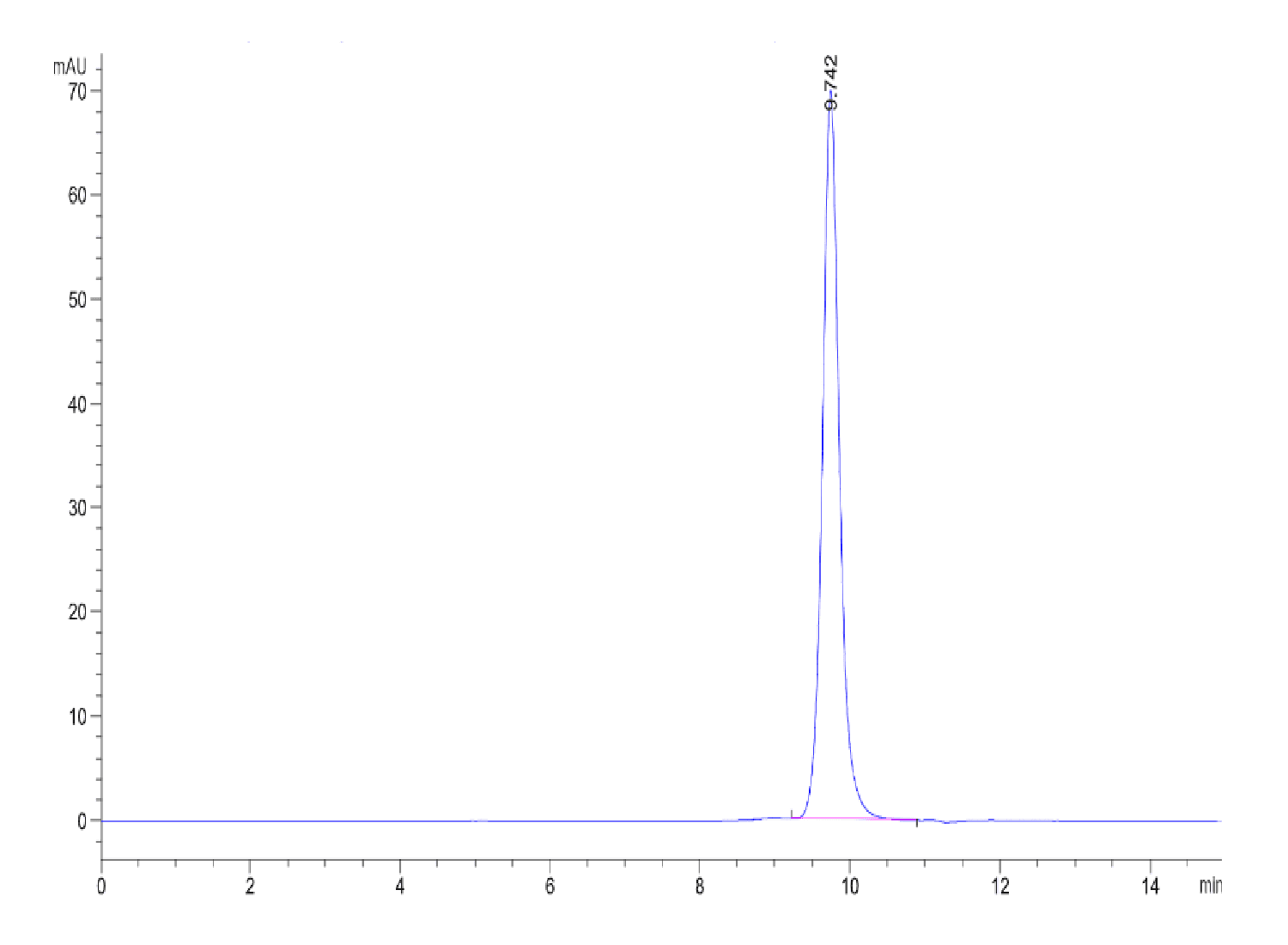| Weight | 1 lbs |
|---|---|
| Dimensions | 9 × 5 × 2 in |
| accession | O43866 |
| express system | HEK293 |
| product tag | C-His |
| purity | > 95% as determined by Tris-Bis PAGE;> 95% as determined by HPLC |
| background | CD5L, a soluble protein belonging to the SRCR superfamily, is expressed mostly by macrophages in lymphoid and inflamed tissues. The expression of this protein is transcriptionally controlled by LXRs, members of the nuclear receptor family that play major roles in lipid homeostasis.CD5L, its roles at the intersection between lipid homeostasis and immune response, and its potential use as a diagnostic biomarker in a variety of diseases, such as TB and liver cirrhosis. |
| molecular weight | The protein has a predicted MW of 37.2 kDa. Due to glycosylation, the protein migrates to 40-50 kDa based on Tris-Bis PAGE result. |
| available size | 100 µg, 500 µg |
| endotoxin | Less than 1EU per μg by the LAL method. |
Human CD5L Protein 3803
$300.00 – $1,000.00
Summary
- Expression: HEK293
- Pure: Yes (HPLC)
- Amino Acid Range: Ser20-Gly347
Human CD5L Protein 3803
| protein |
|---|
| Size and concentration 100, 500µg and liquid |
| Form Liquid |
| Storage Instructions Valid for 12 months from date of receipt when stored at -80°C. Recommend to aliquot the protein into smaller quantities for optimal storage. Please minimize freeze-thaw cycles. |
| Storage buffer Shipped with dry ice. |
| Purity > 95% as determined by Tris-Bis PAGE |
| target relevance |
|---|
| CD5L, a soluble protein belonging to the SRCR superfamily, is expressed mostly by macrophages in lymphoid and inflamed tissues. The expression of this protein is transcriptionally controlled by LXRs, members of the nuclear receptor family that play major roles in lipid homeostasis.CD5L, its roles at the intersection between lipid homeostasis and immune response, and its potential use as a diagnostic biomarker in a variety of diseases, such as TB and liver cirrhosis. |
| Protein names CD5 antigen-like (Apoptosis inhibitor expressed by macrophages) (hAIM) (CT-2) (IgM-associated peptide) (SP-alpha) |
| Gene names CD5L,CD5L API6 UNQ203/PRO229 |
| Mass 9606Da |
| Function Secreted protein that acts as a key regulator of lipid synthesis: mainly expressed by macrophages in lymphoid and inflamed tissues and regulates mechanisms in inflammatory responses, such as infection or atherosclerosis. Able to inhibit lipid droplet size in adipocytes. Following incorporation into mature adipocytes via CD36-mediated endocytosis, associates with cytosolic FASN, inhibiting fatty acid synthase activity and leading to lipolysis, the degradation of triacylglycerols into glycerol and free fatty acids (FFA). CD5L-induced lipolysis occurs with progression of obesity: participates in obesity-associated inflammation following recruitment of inflammatory macrophages into adipose tissues, a cause of insulin resistance and obesity-related metabolic disease. Regulation of intracellular lipids mediated by CD5L has a direct effect on transcription regulation mediated by nuclear receptors ROR-gamma (RORC). Acts as a key regulator of metabolic switch in T-helper Th17 cells. Regulates the expression of pro-inflammatory genes in Th17 cells by altering the lipid content and limiting synthesis of cholesterol ligand of RORC, the master transcription factor of Th17-cell differentiation. CD5L is mainly present in non-pathogenic Th17 cells, where it decreases the content of polyunsaturated fatty acyls (PUFA), affecting two metabolic proteins MSMO1 and CYP51A1, which synthesize ligands of RORC, limiting RORC activity and expression of pro-inflammatory genes. Participates in obesity-associated autoimmunity via its association with IgM, interfering with the binding of IgM to Fcalpha/mu receptor and enhancing the development of long-lived plasma cells that produce high-affinity IgG autoantibodies (By similarity). Also acts as an inhibitor of apoptosis in macrophages: promotes macrophage survival from the apoptotic effects of oxidized lipids in case of atherosclerosis (PubMed:24295828). Involved in early response to microbial infection against various pathogens by acting as a pattern recognition receptor and by promoting autophagy (PubMed:16030018, PubMed:24223991, PubMed:24583716, PubMed:25713983). |
| Subellular location Secreted. Cytoplasm. Note=Secreted by macrophages and circulates in the blood (PubMed:24223991, PubMed:24804991). Transported in the cytoplasm via CD36-mediated endocytosis (By similarity). |
| Tissues Expressed in spleen, lymph node, thymus, bone marrow, and fetal liver, but not in non-lymphoid tissues. |
| Structure Interacts with FASN; the interaction is direct (By similarity). Interacts (via SRCR2 and SRCR3) with pentameric IgM (via Fc region); disulfide-linked (PubMed:24804991, PubMed:8034987). |
| Post-translational modification Not N-glycosylated (PubMed:23236605). Probably not O-glycosylated (PubMed:23236605). |
| Target Relevance information above includes information from UniProt accession: O43866 |
| The UniProt Consortium |
Data
 |
| The purity of Human CD5L is greater than 95% as determined by SEC-HPLC. |
 |
| Human CD5L on Tris-Bis PAGE under reduced condition. The purity is greater than 95%. |
Publications
Publications
| pmid | title | authors | citation |
|---|---|---|---|
| We haven't added any publications to our database yet. | |||
Protocols
| relevant to this product |
|---|
Documents
| # | ||
|---|---|---|
| Please enter your product and batch number here to retrieve product datasheet, SDS, and QC information. | ||














